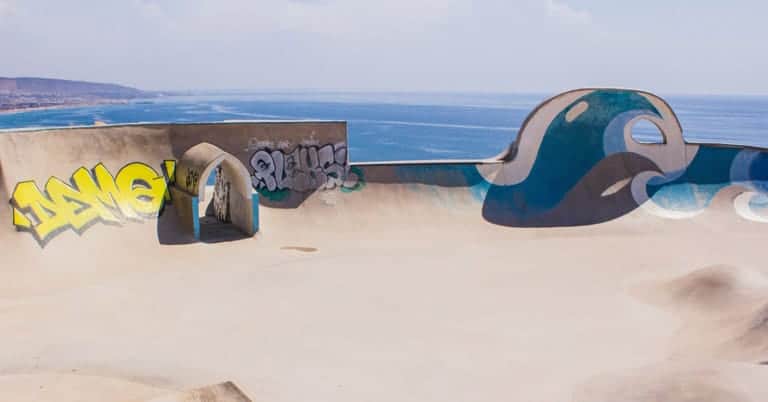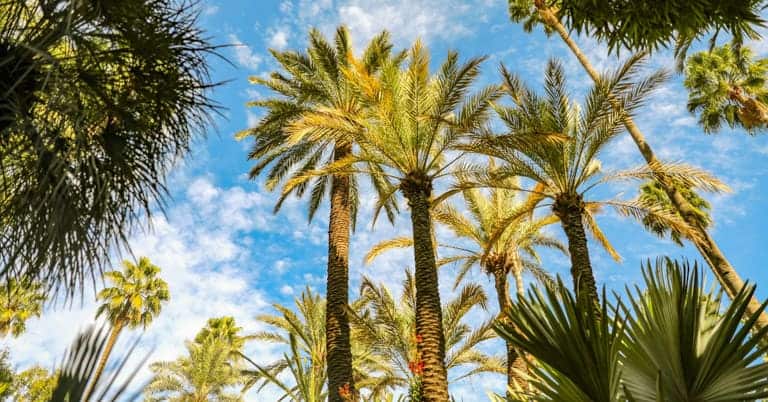
This post describes and explains the average weather conditions in Taghazout throughout the year. It provides tips on when to go, what to expect, and what to do, but first of all, let us explain few things about the Climate here.
Jump to your content
What is Taghazout weather like ?
The region is situated on the edge of the Sahara. This makes Taghazout a semi-arid village with two seasons more or less: Summer and Winter.
Extreme cold is rather non-existent as the temperature in winter rarely goes below 12-15 °Celcius (C) during the day. Extreme heat is pretty rare as well, but it may happen that the temperature exceeds 40°C or more, mainly in July or August and mostly in the inland areas.
The average annual precipitations don’t exceed 300 mm. Due to that, Argan trees and plants, which require less water, are the main vegetation found here.
What are the best surf conditions in Taghazout?
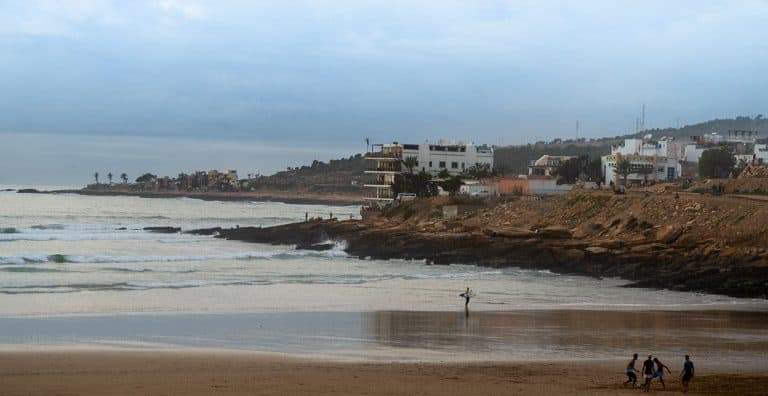
Taghazout is the first surfing destination in Morocco with several surf spots suitable for all levels.
For advanced surfers, the most consistent surfing season goes between December and early March, and it is the best time to go! During this period, the temperature of the ocean ranges from 16°C to 19°C, and a wet-suit is needed. Because light winds may pick up in the afternoons, the mornings are usually the best time to surf but, of course, it depends on the tide and spots. Most of the waves are right handed. Anchor point, Boilers and Banana are among the best right breaks around.
For intermediate surfers, the surf season starts from early October to the end of April. A wet-suit is not necessarily needed the first two months of the season as water temperature can vary between 19°C and 22°C. In the middle of April, the wind picks up almost every afternoon and makes the waves choppy.
For Beginners, surfing between December and February can be challenging. To overcome frustration, guarantee fun and improve your level, it is better to learn outside the peak season. There is still a possibility to find friendly spots in winter like beach breaks (Panorama Beach and Imsouane Bay at low tide, K17, Agadir… etc)
Magicseaweed and Windguru are the main forecast website to check here, but you don’t want to completely rely on these two; they provide more or less the same forecast about surf spots next to each other, even if these ones work on different tides or wind directions. Sometimes they claim epic surf when actually there is nothing, or the opposite.
Talk to locals, know if a storm is coming (Potential swell), check the wind direction, and learn how local spots function… etc.
Before taking their clients anywhere, some surf camps drive along the coast to check waves the old way, or get calls from surfers living right in front of the spots.
Taghazout Weather: When to go?
What is the average monthly weather in Taghazout?
In Taghazout and around, Winter is mild and slightly rainy whereas Summer is hot (although not excessive) and without rain. The cold Atlantic current which runs along the coast can also cause fogs and low clouds, especially in the warmer months.
Although the climate is generally mild, hot air masses coming of the Sahara can increase temperatures in winter up to around 30°C, while in summer they can bring a torrid heat. This can happen especially in July and August but mainly in the inland mountains (40°C).
In recent years, Heat waves are becoming more common (In July 2013, the maximum temperature exceeded 42°C for 6 days in a row.
The Rain is rare as the average amount of precipitation falling totals 220 mm per year. Almost all rain falls from October to April. However, it may be stronger than usual, and because the dry land doesn’t easily absorb water, the flood can occur… rarely though.
Winter in Taghazout
From December to February, Winter in Taghazout is very mild, especially during the day, as the average temperatures are about 20°C, while nights can be cold sometimes (temperatures can fall below 5°C).
Rains are rare in general. Sometimes, it does not rain for a whole month, but the area can also receive abundant rains for a few days.
What about Snow?? No it doesn’t snow around, but surprisingly, last winter, it did snow for a couple of days around Imouzzer mountains, and we could even see the snow from the hills of Tamraght village! Such a wonderful view.
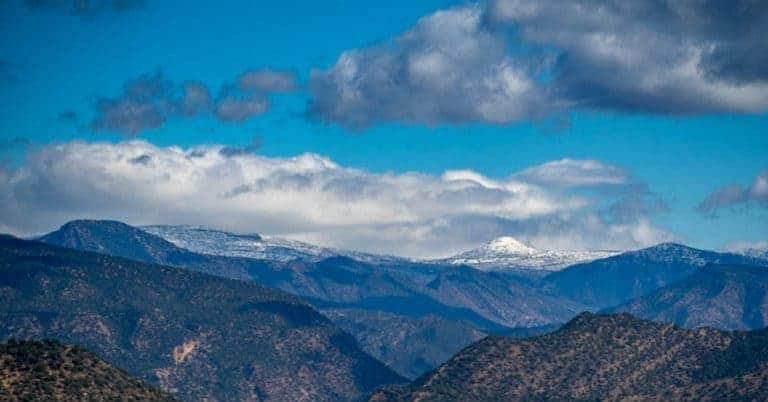
View from Tamraght hills on the snowy mountains of Imouzzer (last Winter)
Winter is perfect to visit Taghazout even if the days are shorter. You can surf, skate, bike, do yoga… or simply walk by the coast.
When the swell is heavy, Anchor point surfing spot creates a real show. Even if you are not into surfing, you do not want to miss the spectacle. Check the forecast or ask surfers.
Winter is also a good time to go hiking around Taghazout and Paradise Valley. The sky is clear and sunsets are breathtaking. After the first rains, the leafless Argan forest starts to look greener, the Almond trees blossom in late February, and the migrant birds start to come back. … maybe you need to check the changes by yourself, otherwise, this paragraph won’t end (Besides, I am not good when it comes to the poetic description of nature).
December
December is a busy month. it is the real beginning of the surfing season, but also Christmas time. You may want to book ahead to avoid surprises.
- Temperature
During December, Taghazout profits from a mild weather with a very good sunning (7 hours of daylight). The average temperatures fluctuate between 8°C in the morning and et 23°C by midday. In the evening, temperatures can decrease with an average of 5°C.
- Sea water
Water temperature is between 17°C and 19°C. Swimming is possible even if the sea water starts to be cool by now. If you hesitate, rent a wet-suit.
- Rain
Usually, there is an average of 5 rainy days, except that it didn’t rain this last year.
January
January is one of the busiest surfing months and an ideal time to visit Taghazout. The weather is cool and the sunsets are mesmerizing.
- Temperature
On average, temperature varies between 13°C in the morning and 21°C by midday. In the evening, temperatures can decrease with an average of 5°C.
- Sea water
Water temperature is between 16°C and 18°C. You can still enjoy a quick swim; it boosts your immune system 😊
- Rain
Usually, there is some rain in this time of the year. Last year, we had a total of 13mm over the month. This year, on the other hand, we had a warm January with no rain…. Yes! No Rain
In case it rains, it is better to avoid swimming right after the rain.
February
Like January, February is also an ideal time to visit Taghazout. In addition to surfers and young travellers, many campervans drive along the coast seeking the mild climate of the south during winter.
- Temperature
February was exceptionally hot and dry this year probably due to the dry air coming from the Sahara. The highest temperature recorded was 30°C!!!, but in general, this month is very similar to January with a mild day and a chilly night… I guess, with the climate change, it is becoming hard to provide a clear information!!
- Sea water
Water temperature ranges between 16°C and 19°C. Like January, don’t hesitate to go for a quick swim especially after a long walk by the beach. Water is very refreshing!
- Rain
Much of the precipitation occurs in the form of short, heavy bursts of rainfall. Last year, we had a total of 41mm over the month compared to 1 little tiny millimeter this year!!
In general, it is better to avoid swimming right after the rain.
Spring in Taghazout
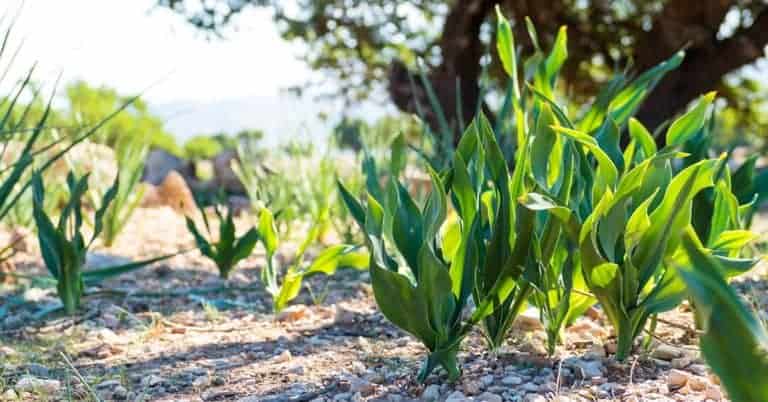
Spring is an ideal time to start surf lessons as the waves begin to decrease in power. You will also see more people hitting the beaches. If you plan on spending few days at Imsouane, Check the wind forecast first. Don’t just go!!
There are more activities to enjoy by now like swimming, Beach walks, skating, biking, beach yoga, paragliding, hiking, day trips…. and other activities not so friendly to the environment.
March
March marks the beginning of spring. I mean, not that you will see any difference, no colourful butterflies nor roses. You will need to hike Aqsri mountains to notice all that.
The weather is again suitable for any outdoor activity. It is also ideal for travellers looking for cheap flights and an off-season trip.
- Temperature
On average, the temperature varies between 17°C and 22°C. Once the sun goes down, it drops to 12°C. Daylight hours also increase starting from March (9 hours).
However, last March was another warm and dry month. The highest temperature recorded was 30°C!!!
- Sea water
Water temperature ranges between 17°C and 19°C. Again, a quick jump in water will leave you feeling refreshed. Don’t hesitate 😊
- Rain
Last year, we had a total of 27mm over the month compared to 17 mm this year. Usually, the rain shouldn’t prevent you from going out. A light and thin raincoat will be enough to protect you. Actually, it is fun to wander around in the rain here.
April
April marks Easter school holidays. If Taghazout is your destination, you will not be disappointed with the climate. Even if the wind picks up most of afternoons, the mornings are cool and the afternoons are rather sunny, and you will find plenty of activities to enjoy with children.
- Temperature
On average, the temperature varies between 16°C in the mornings and 24°C by midday and it drops below 14°C at nights, but again both last year and this year, April was rather warm with 30°C as the highest temperature recorded. During the afternoons, the wind picks up most of the afternoons with a speed exceeding 20 KM/H. This makes sunbathing at a sandy beach less fun, especially around Devil’s rock beach.
- Sea water
Water temperature increases by few degrees to reach 19°C. By now, you will start to see locals at the beach but mainly during the weekends. Few surfers already begin taking off their wet-suits.
- Rain
This year, we had a total of 39 mm over the month compared to only 13 mm last year. Surprise!
May
May is the off-season month by excellence. Likewise, Taghazout will be empty and prices will be low. This month comes in between the surf season and the summer season. If you are looking for cheap prices and fewer crowds, you might want to consider this month.
- Temperature
On average, the temperature varies between 18°C and 26°C and the nights start to become warm enough. Like April, the beginning of May is marked by windy afternoons with a speed exceeding 15 KM/H.
- Sea water
Water temperature is warm enough for swimming (19°C and 20°C sometimes). The waves are less perfect or non-existent sometimes, but if you check the forecast, you can still find spots with waves around.
- Rain
It almost never rains from May to September.
Summer in Taghazout

June
June feels like summer already. You can spend your whole day at the beach but you need to protect your skin from the sun. Days are long and water is warm
- Temperature
This is the beginning of the Summer heat because temperatures start to exceed 30°C.
- Sea water
Water temperature is warm enough for swimming (19°C and 20°C sometimes). There are some small waves left to surf at Devil’s rock spot and Anza. The rest is flat.
July and August
The weather during these two months is rather the same. The town becomes the most crowded, and the traffic jam is the worst as Taghazout gathers some of the most solicited beaches of the area, but at least water is perfect to go for a swim and the daylight hours are very long.
- Temperature
During July and August, a thick fog covers the coastline, but at least keeps the weather in Taghazout cooler than in other cities. This phenomenon is caused when the inland hot air and comes in touch with the cold current of the sea. People looking for some real suntan might be disappointed.
- Sea water
Water temperature is warm enough for swimming as it rises to reach 22°C. Sometimes, there are some nice waves to ride during August, especially at Devil’s rock beach.
Autumn in Taghazout

It is still beach time but with way less people. You can take surf lessons as the waves are still friendly. In general, expect to enjoy the same activities of Winter and Spring like swimming, Beach walks, skating, biking, beach yoga, paragliding, hiking, day trips…. and the same other activities not so friendly to the environment.
September
I think this month should rather be part of the Summer season; it is hot and rain is unlikely to happen.
Unless you are a surfer (or a parent), you should consider September if you want to step out of the crowd and still enjoy some warm weather … peacefully.
- Temperature
On average, temperature varies between 26°C and 28°C, and sometimes it can reach 32°C. The sky is clear and the sun is rather strong (It is important to protect your skin). The daylight hours are still long (more than 12H).
- Sea water
Water temperature is 21°C and swimming should be fun. You are likely to be alone in water as well, summer people and lifeguards are already gone!
September is not usually a wave month, but who knows! a surprise swell may hit in September…. Stay optimistic😊
- Rain
It hardly ever rain in September. Last year, we had a total of 13mm over the month (3 days) and it came as a surprise. This year, September was rather a hot month with no rain.
October
The pleasant warmth and the blue skies are still around. Actually, this month is very similar to September with two exceptions: It rains a little bit sometimes and the waves start to come back.
- Temperature
In general, the average temperature varies between 22°C and 27°C. Last October was rather hot with 34°C as the highest temperature recorded.
Daylight hours are still long; the sun rises at 6:40 and goes down by 18:07.
- Sea water
Water temperature is about 20°C. The surf and the surfers slowly come back in town.
You can still surf without a wetsuit in October. At least that was the cased last year! Wait! Before you decide to leave your wetsuit home, because you want to pack light, check the forecast.
- Rain
The first rain drops of the season fall by mid-October. Last year, we had a total of 70mm over the whole month.
November
This is a mild month. The weather change is rather smooth, as temperature continues to decrease very slowly.
- Temperature
The average temperatures vary between 17°C in the morning and et 23°C by midday. At the end of the day, temperatures drop to 21°C. Last year, 28°C was the highest temperature recorded.
By mid-November, the weather starts cooling down quite quickly.
- Sea water
Water temperature is between 18°C and 19°C. the surf is a little bit more consistent than the previous summer months.
- Rain
The real rain season technically arrives in November. Last year, we had a total of 57 mm mm.

By Mbarka
– You may Also like –

